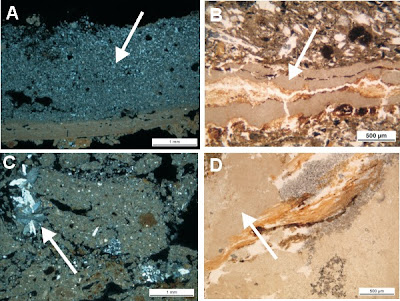Micrograph of the Month: Varieties of Gypsum 1
 | |
| A: gypsum plaster (Tell Brak, building) B. microcrystalline gypsum (Catalhoyuk, midden) C. gypsum rosette (Kamiltepe, building) D. microcrystalline gypsum (Kamiltepe, external area) |
In micrographs B and D we can see microcrystalline gypsum, where the individual crystals are very small, and have precipitated within void spaces (in B the void is a crack, in D a plant void). In micrograph C we can see an example of a small 'gyspum rose', where the crystals form a rosette pattern.
Another type which can be seen in last month's blog is called prismatic gypsum, unsuprisingly due to the single crystals being prism shaped. Similar to this is lenticular gypsum, where the crystals are more rounded and 'lens' shaped. According to Cody (1979), lenticular crystals form in the presence of plant organic matter under alkaline conditions.
Perhaps the most interesting of these images is A, which shows a layer of gypsum plaster in a building at the site of Tell Brak, Syria in cross polarised light (micromorphology studied by Dr Wendy Matthews, University of Reading). It is very similar in appearance to microcrystalline gypsum, but you can see that it has been prepared as a surface - the pale grey-brown in the lower part of the image shows layers of plaster 'wash' over the thicker gypsum surface.
Cody, R.D., 1979. Lenticular gypsum: occurrences in nature and experimental determinations of effects of soluble green plant material on its formation. Journal of Sedimentary Petrology 49: 1015-1028

Comments
Post a Comment